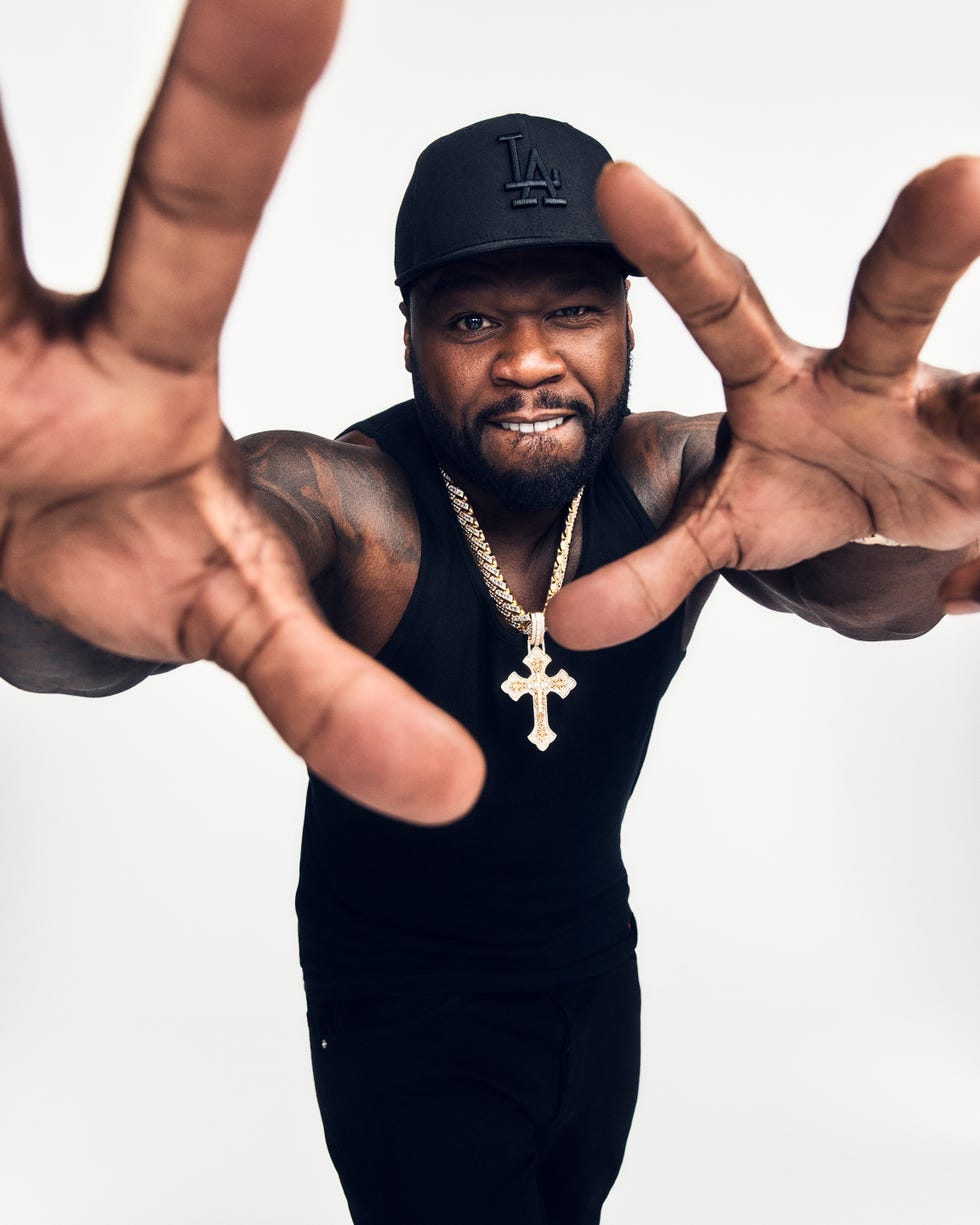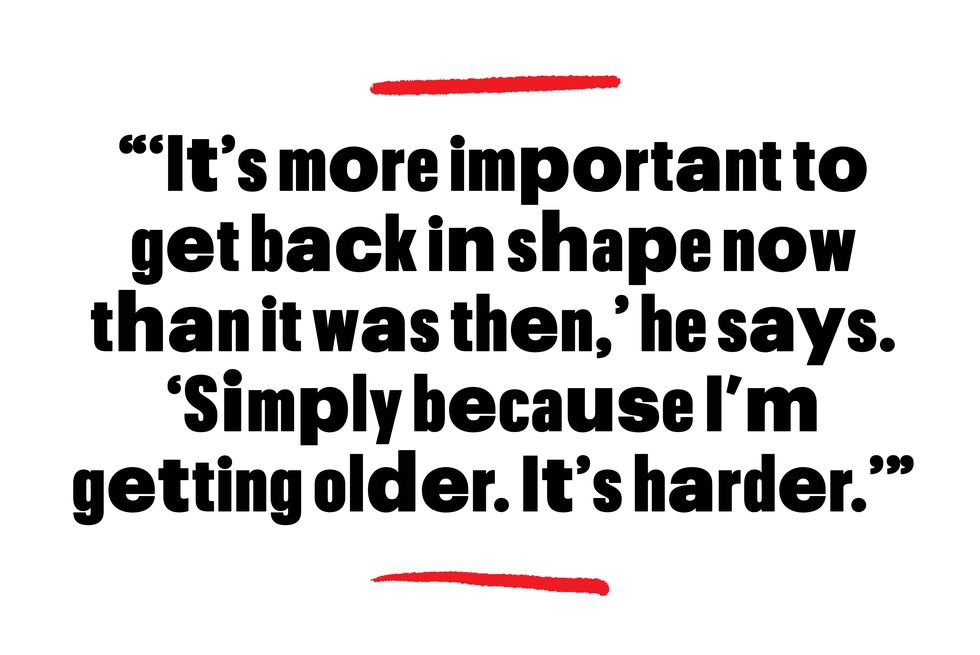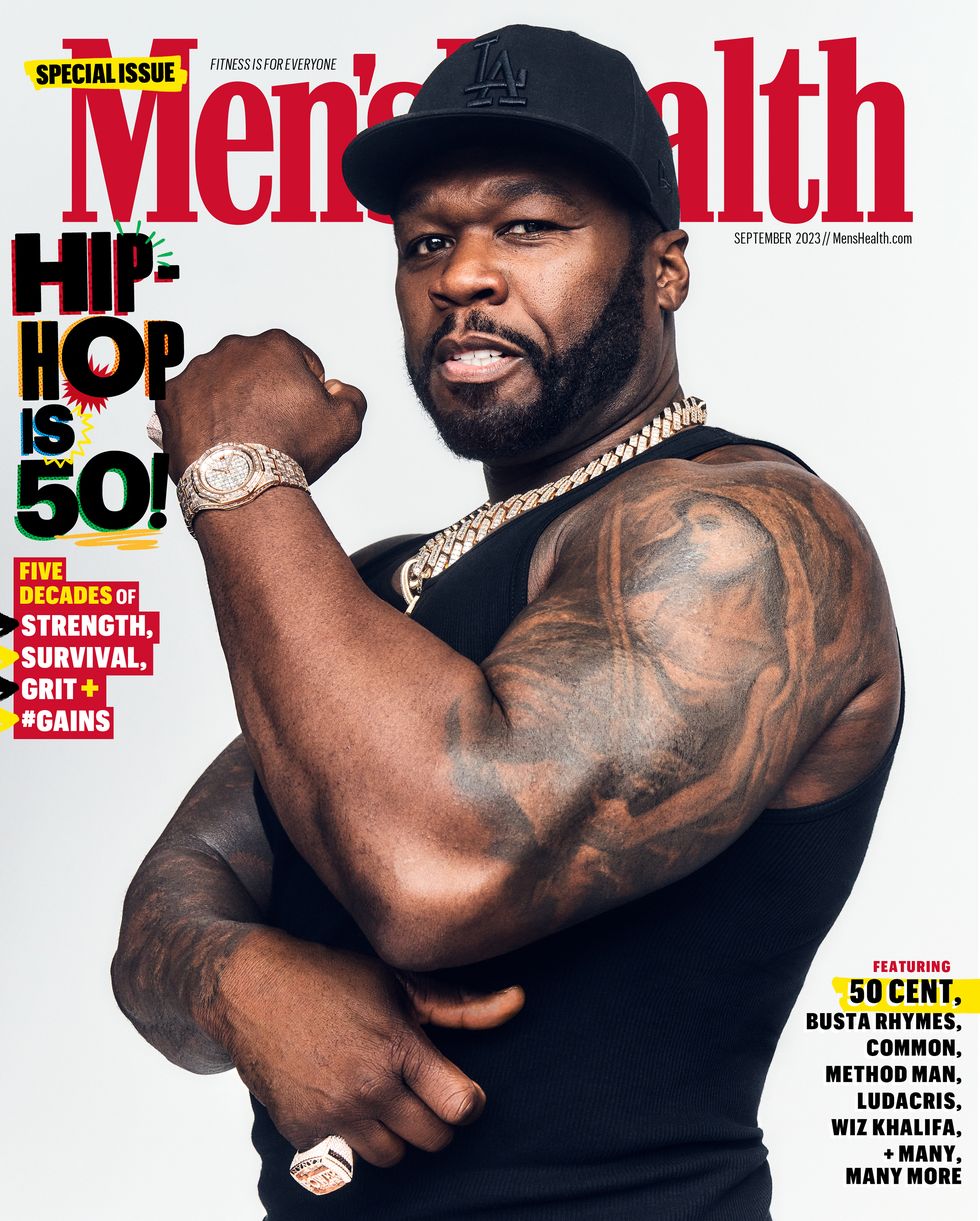This cover story is part of Hip-Hop Is Life, a series of profiles and features that revisit key moments in the intersection of hip-hop and Black men’s health over the last 50 years. Read the rest of the stories here.
FOR CURTIS “50 CENT” Jackson, the treadmill scene in his now iconic “In Da Club” video is symbolic. Before he got there, he’d been famously shot nine times in 2000. Nerve damage prevented him from walking unassisted. He relocated to the Poconos from the Jamaica, Queens, neighborhood of New York City, where he was raised and nearly killed. Eventually, he skipped the grueling four-hour round trips to Jamaica Hospital to get (free) physical therapy in favor of a personal treadmill regimen. Two years later, the entire world saw his chiseled triumph in all its shirtless glory, jogging to a Dr. Dre beat while on the verge of releasing a debut album that would go on to sell 12 million records. “I put the gym in the middle of the video because, to me, that’s where I looked the coolest,” says Jackson. “That’s where I learned strong is not all muscle; it’s about being mentally and physically strong.”
Ironically, the attempt on 50’s life was the tipping point for him becoming the 200-pound (plus six percent body fat) herculean MC who bullied music artists and the charts for much of the aughts. One of those nine bullets pierced his jaw, placing him on a liquid diet for six weeks. He shed nearly 54 pounds off a frame that had been stocky since he began boxing at age 12. “[As a kid] I didn’t do well in team sports,” he says mid-reflection. “I would always identify with why we lost. So it was perfect to get into boxing, because there was no one to blame anything on. Boxing gave me a discipline that gives you an advantage.”
That discipline was necessitated by tragedy. After the murder of his mother, he became an orphan at age eight. This led to his role models and father figures primarily being neighborhood criminals who occupied public-housing projects and went by Five Percenter monikers like “Allah” and “Understanding.” For better or worse, these hustlers took young “Boo Boo” (a childhood nickname given to him by his aunt Geraldine) under their wings and landed him in the ring. “I learned from people who didn’t have excuses,” he says. “They looked at it like, ‘Curtis, if you would’ve [trained] like you was supposed to, you wouldn’t have gotten tired in that last round.’ So you can figure it out or go home punch-drunk. I’d rather do the work.”
While being shot several times is unequivocally traumatic, unfortunately, it’s also common in underserved communities like South Jamaica, Queens. But 50 refused to let an attempt on his life kill his dreams. The weight loss caused by his assault gifted the MC two observations that would forever change him: For the first time in Fif’s life, he could see the muscle constellation his weight had hidden throughout his years. “When you slim down, you see everything,” he says before identifying the paranoia in his initial fitness journey. “I’m also working out to get myself stronger, ’cause who’s to say you’re not gonna get hit again?”
The second observation was not in the mirror but instead on television. He saw D’Angelo’s “How Does It Feel (Untitled)” video and the subsequent female reaction to the Brown Sugar crooner’s defined physique. “They were talking about a Brad Pitt line!” says 50, referring to the Fight Club actor’s famously defined pelvis. “I’m like, ‘Wait, what’s that?! Oh, nah, that’s important!’”
It’s been 20 years since Get Rich or Die Tryin’ and its abdominal ad of an album cover consumed the world and ignited what many rap purists have deemed the “G-Unit Era,” the four-year run when 50 and his G-Unit Records roster dropped an onslaught of undeniable rap releases that seized both the streets and Billboard charts. Today, Jackson is a metamorphosed hybrid in the entertainment business with a professional resume that’s transcended the rap booth. He’s spent the last decade learning and imposing his will on the motion picture industry—similar to his entry into the music biz—and now his rap legend tag is accompanied by the distinction of being a highly successful film and TV exec. He boasts “30 different shows across ten different networks,” including several spin-offs from his initial Power series, which continues to break nearly every existing Starz ratings record; an animation project with Nicki Minaj; and an 8 Mile scripted series. All while continuing to keep a finger on the pulse of Hip-Hop. “Culturally, things move way faster now,” he says. “We have subcultures, street music like Drill. If I were [actively rapping] in this era, I would’ve fallen into that subgenre of rap.”
Although he’s two generations removed from today’s MCs, his influence on young Black men desperately using spoken word to escape the trappings of inner-city underworlds is as undeniable as it is current. 21 Savage remade 50’s grave classic “Many Men.” Fif also agrees that no other music artist of this era resembled him more than the late Pop Smoke. “I saw so much of myself in him,” says Jackson about the slain Brooklyn rapper before providing levity. “I was like, ‘What’s your mother’s name again?’”
50’s new career also came with 20 more pounds than he had 20 years ago. During the pandemic, he swelled to 235 pounds but defends the fatty gains as intentional and occupational. “I put more weight on for the role on the ABC show [For Life]. I was eating everything to get as big as possible. Because it was a jailhouse [role], so it didn’t matter if I wasn’t cut up.”
On the set of the September Men’s Health cover shoot, he’s down ten pounds since the pandemic and a month away from his 48th birthday. While Method Man showcases his gym results for the photographer, 50—sporting an all-black tank top, jeans, and fitted cap—vacillates between comedic, fitness, and business conversations with cover mate Busta Rhymes. Busta is on a mission to bulk up; 50 aims to drop more body fat. The vanity focus is attributed to both rappers preparing for late-summer ’23’s “The Final Lap Tour,” Jackson’s last global run as rapper 50 Cent. When Fif walked on set, he had 83 dates secured. That was before he was informed at the photo shoot that 20 more shows had been added. That many flights and performances will certainly tax a middle-aged body. This is why the Grammy and Emmy winner is determined to return to “In Da Club” form.
“When I’m in top shape, I’m not sweating until song four,” he says before taking a dig at out-of-shape performers. “They sweatin’ on the second verse. Like, ‘You just got out there and you soaking wet!’”
50 Cent may not feel as urgent as he did in 2003, but the multihyphenate’s ambition and business intuition is as present as the discipline he gained in those South Jamaica boxing gyms. While in some ways he’s changed over the couple of decades (i.e., marginally less aggressive, with no recent threats against anyone’s life), he’s essentially the same Queens kid eager to remove impediments by any means necessary. He is and has always been his greatest competition. He still aches for a challenge. So whether that calls for dominating network television or Ja Rule or relearning how to walk, triumph is his only option—especially when the stakes and obstacles are at their highest. “It’s more important to get back in shape now than it was then,” he says with his signature imp smirk. “Simply because I’m getting older. It’s harder.”
A version of this story appeared in the September 2023 issue of Men’s Health.
All shoots and interviews for this cover were conducted prior the SAG-AFTRA strike.
Writer
Bonsu Thompson is a writer, producer and Brooklynite who co-wrote award winning film, created and produced digital and feature-length documentaries, while earning titles at publications such as MTV2, XXL, The Source, and SLAM Magazine. In 2019, Bonsu became a fellow of both Winter and Summer 2019 Sundance Screenwriters Labs.






Comments are closed.